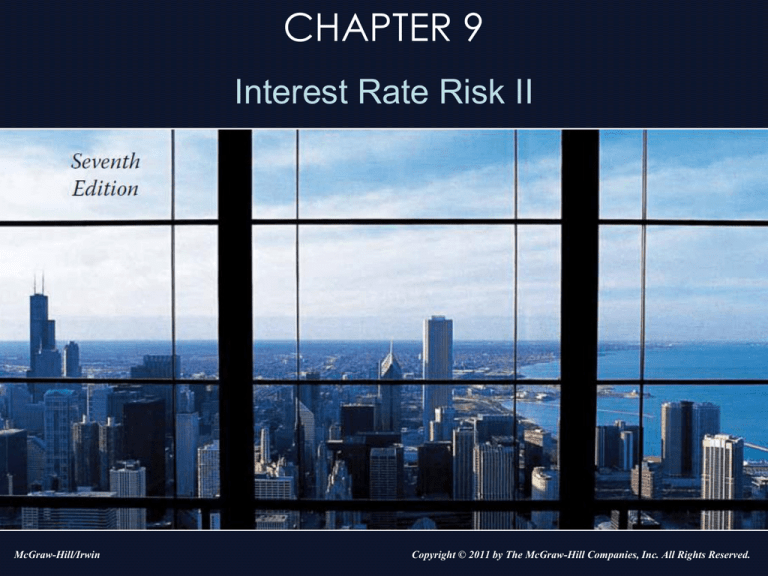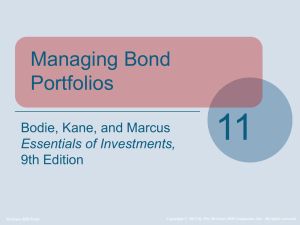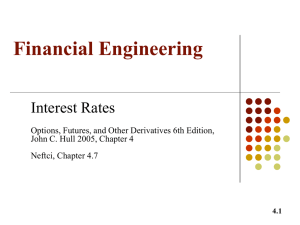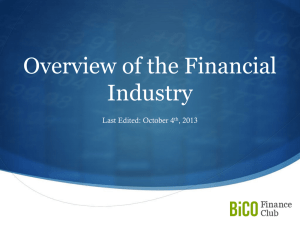
CHAPTER 9
Interest Rate Risk II
McGraw-Hill/Irwin
Copyright © 2011 by The McGraw-Hill Companies, Inc. All Rights Reserved.
Overview
This chapter discusses a market valuebased model for assessing and
managing interest rate risk:
–
–
–
–
–
Duration
Computation of duration
Economic interpretation
Immunization using duration
*Problems in applying duration
9-2
Price Sensitivity and Maturity
In general, the longer the term to
maturity, the greater the sensitivity to
interest rate changes
Example: Suppose the zero coupon
yield curve is flat at 12%. Bond A pays
$1790.85 in five years. Bond B pays
$3207.14 in ten years, and both are
currently priced at $1000.
9-3
Example continued...
– Bond A: P = $1000 = $1790.85/(1.06)10
– Bond B: P = $1000 = $3207.14/(1.06)20
Now suppose the annual interest rate
increases by 1% (0.5 % semiannually).
– Bond A: P = $1762.34/(1.065)10 = $954.03
– Bond B: P = $3105.84/(1.065)20 = $910.18
The longer maturity bond has the
greater drop in price because the
payment is discounted a greater
number of times.
9-4
Coupon Effect
Bonds with identical maturities will
respond differently to interest rate
changes when the coupons differ. This
is easily understood by recognizing
that coupon bonds consist of a bundle
of “zero-coupon” bonds. With higher
coupons, more of the bond’s value is
generated by cash flows which take
place sooner in time. Consequently, it
is less sensitive to changes in R.
9-5
Remarks on Preceding Slides
In general, longer maturity bonds
experience greater price changes in
response to any change in the
discount rate
The range of prices is greater when the
coupon is lower
– A 6% bond will have a larger change in
price in response to a 2% change than an
8% bond
– The 6% bond has greater interest rate risk
9-6
Extreme Examples With Equal Maturities
Consider two ten-year maturity instruments:
– A ten-year zero coupon bond
– A two-cash flow “bond” that pays $999.99
almost immediately and one penny ten years
hence
Small changes in yield will have a large
effect on the value of the zero but almost
no impact on the hypothetical bond
Most bonds are between these extremes
– The higher the coupon rate, the more similar the
bond is to our hypothetical bond with higher
value of cash flows arriving sooner
9-7
Duration
Duration
– Weighted average time to maturity using
the relative present values of the cash
flows as weights
– Combines the effects of differences in
coupon rates and differences in maturity
– Based on elasticity of bond price with
respect to interest rate
– The units of duration are years
9-8
Macaulay Duration
Macaulay Duration
Where
D = Macaulay duration (in years)
t = number of periods in the future
CFt = cash flow to be delivered in t periods
N= time-to-maturity
DFt = discount factor
9-9
Duration
Since the price (P) of the bond equals
the sum of the present values of all its
cash flows, we can state the duration
formula another way:
Notice the weights correspond to
the relative present values of the
cash flows
9-10
Semiannual Cash Flows
It is important to see that we must
express t in years, and the present
values are computed using the
appropriate periodic interest rate. For
semiannual cash flows, Macaulay
duration, D is equal to:
9-11
Duration of Zero-coupon Bond
For a zero-coupon bond, Macaulay
duration equals maturity since 100% of
its present value is generated by the
payment of the face value, at maturity
For all other bonds, duration < maturity
9-12
Computing duration
Consider a 2-year, 8% coupon bond,
with a face value of $1,000 and yieldto-maturity of 12%
Coupons are paid semi-annually
Therefore, each coupon payment is
$40 and the per period YTM is (1/2) ×
12% = 6%
Present value of each cash flow
equals CFt ÷ (1+ 0.06)t where t is the
period number
9-13
Duration of 2-year, 8% bond:
Face value = $1,000, YTM = 12%
t
years CFt
PV(CFt)
1
0.5
40
37.736
Weight W × years
(W)
0.041
0.020
2
1.0
40
35.600
0.038
0.038
3
1.5
40
33.585
0.036
0.054
4
2.0
1,040 823.777
0.885
1.770
P = 930.698
1.000
D=1.883
(years)
9-14
Special Case
Maturity of a consol: M = .
Duration of a consol: D = 1 + 1/R
9-15
Features of Duration
Duration and maturity
– D increases with M, but at a decreasing
rate
Duration and yield-to-maturity
– D decreases as yield increases
Duration and coupon interest
– D decreases as coupon increases
9-16
Economic Interpretation
Duration is a measure of interest rate
sensitivity or elasticity of a liability or
asset:
[ΔP/P] [ΔR/(1+R)] = -D
Or equivalently,
ΔP/P = -D[ΔR/(1+R)] = -MD × ΔR
where MD is modified duration
9-17
Economic Interpretation
To estimate the change in price, we
can rewrite this as:
ΔP = -D[ΔR/(1+R)]P = -(MD) × (ΔR) × (P)
Note the direct linear relationship between
ΔP and -D
9-18
Dollar Duration
Dollar duration equals modified
duration times price
Dollar duration = MD × Price
Using dollar duration, we can compute
the change in price as
ΔP = -Dollar duration × ΔR
9-19
Semi-annual Coupon Payments
With semi-annual coupon payments
the percentage change in price is
ΔP/P = -D[ΔR/(1+(R/2)]
9-20
Immunization
Matching the maturity of an asset
investment with a future payout
responsibility does not necessarily
eliminate interest rate risk
Matching durations will immunize
against changes in interest rates
9-21
An Example
Consider three loan plans, all of which
have maturities of 2 years. The loan
amount is $1,000 and the current
interest rate is 3%.
Loan #1 is a two-payment loan with
two equal payments of $522.61 each.
Loan #2 is structured as a 3% annual
coupon bond.
Loan #3 is a discount loan, which has
a single payment of $1,060.90.
9-22
Duration as Index of Interest Rate Risk
Yield
Loan Value
2%
3%
ΔP N D
Equal
$1014.68 $1000 $14.68 2 1.493
Payment
3% Coupon $1019.42 $1000 $19.42 2 1.971
Discount
$1019.70 $1000 $19.70 2 2.000
9-23
Balance Sheet Immunization
Duration is a measure of the interest
rate risk exposure for an FI
If the durations of liabilities and assets
are not matched, then there is a risk
that adverse changes in the interest
rate will increase the present value of
the liabilities more than the present
value of assets is increased
9-24
Duration Gap
Suppose that a 2-year coupon bond is
the only loan asset (A) of an FI. A 2-year
certificate of deposit is the only liability
(L). If the duration of the coupon bond
is 1.8 years, then:
Maturity gap: MA - ML = 2 -2 = 0, but
Duration Gap: DA - DL = 1.8 - 2.0 = -0.2
– Deposit has greater interest rate sensitivity
than the bond, so DGAP is negative
– FI exposed to rising interest rates
9-25
Immunizing the Balance Sheet of an FI
Duration Gap:
– From the balance sheet, E=A-L. Therefore,
DE=DA-DL. In the same manner used to
determine the change in bond prices, we
can find the change in value of equity
using duration.
– DE = [-DAA + DLL] DR/(1+R) or
– DE = -[DA - DLk]A(DR/(1+R))
9-26
Duration and Immunizing
The formula shows 3 effects:
– Leverage adjusted D-Gap
– The size of the FI
– The size of the interest rate shock
9-27
An Example
Suppose DA = 5 years, DL = 3 years and
rates are expected to rise from 10% to
11%. (Rates change by 1%). Also, A =
100, L = 90 and E = 10. Find change in
E.
DE = -[DA - DLk]A[DR/(1+R)]
= -[5 - 3(90/100)]100[.01/1.1] = - $2.09.
Methods of immunizing balance sheet.
– Adjust DA , DL or k.
9-28
Immunization and Regulatory Concerns
Regulators set target ratios for an FI’s
capital (net worth):
– Capital (Net worth) ratio = E/A
If target is to set D(E/A) = 0:
– DA = DL
But, to set DE = 0:
– DA = kDL
9-29
Limitations of Duration
– Immunizing the entire balance sheet need
not be costly
– Duration can be employed in combination
with hedge positions to immunize
– Immunization is a dynamic process since
duration depends on instantaneous R
– Large interest rate change effects not
accurately captured
Convexity
– More complex if nonparallel shift in yield
curve
9-30
Convexity
The duration measure is a linear
approximation of a non-linear
function. If there are large changes in
R, the approximation is much less
accurate. All fixed-income securities
are convex. Convexity is desirable, but
greater convexity causes larger errors
in the duration-based estimate of price
changes.
9-31
*Convexity
Those who are familiar with calculus
may recognize that duration involves
only the first derivative of the price
function. We can improve on the
estimate using a Taylor expansion. In
practice, the expansion rarely goes
beyond second order (using the
second derivative). This second order
expansion is the convexity adjustment.
9-32
*Modified Duration &
Convexity
– DP/P = -D[DR/(1+R)] + (1/2) CX (DR)2 or
DP/P = -MD DR + (1/2) CX (DR)2
– Where MD implies modified duration and
CX is a measure of the curvature effect.
– CX = Scaling factor × [capital loss from 1bp
rise in yield + capital gain from 1bp fall in
yield]
– Commonly used scaling factor is 108
9-33
*Calculation of CX
Example: convexity of 8% coupon, 8%
yield, six-year maturity Eurobond
priced at $1,000
CX = 108[DP-/P + DP+/P]
= 108[(999.53785-1,000)/1,000 +
(1,000.46243-1,000)/1,000)]
= 28
9-34
*Duration Measure: Other Issues
Default risk
Floating-rate loans and bonds
Duration of demand deposits and
passbook savings
Mortgage-backed securities and
mortgages
– Duration relationship affected by call or
prepayment provisions
9-35
*Contingent Claims
Interest rate changes also affect value
of off-balance sheet claims
– Duration gap hedging strategy must
include the effects on off-balance sheet
items such as futures, options, swaps,
caps, and other contingent claims
9-36
Pertinent Websites
Bank for International
Settlements
Securities Exchange
Commission
The Wall Street Journal
www.bis.org
www.sec.gov
www.wsj.com
9-37









